Abstract
In the present study, we have investigated the mechanisms by which the restoration of wild-type (wt) p53 functions in p53 mutant cells increases their susceptibility to the cytotoxic action of tumor necrosis factor (TNF). Our data indicate that the resistance of p53-mutated cl.1001 cells to TNF-induced cell death was not due to a defect in the expression of TRADD and FADD, yet correlated with a reduced caspase-8 activation as well as a deficient mitochondrial membrane permeabilization. Moreover, cl.1001 cells failed to translocate the mitochondrial AIF and cytochrome c to the nucleus and to the cytosol, respectively, in response to TNF. Sensitization of these cells, following infection with a recombinant adenovirus encoding wtp53, to TNF-induced cytotoxicity resulted in the restoration of caspase-8 cleavage and the reestablishment of mitochondrial signs of apoptosis. These findings suggest that the cross-talk between p53 and TNF-induced cell death depends on mitochondria and that the combination of TNF and Adwtp53 may be a potential strategy to sensitize mutant p53 TNF-resistant tumors to the cytotoxic action of this cytokine.
This is a preview of subscription content, access via your institution
Access options
Subscribe to this journal
Receive 12 print issues and online access
$259.00 per year
only $21.58 per issue
Buy this article
- Purchase on Springer Link
- Instant access to full article PDF
Prices may be subject to local taxes which are calculated during checkout






Similar content being viewed by others
References
Wallach D, Varfolomeev EE, Malinin NL et al. Tumor necrosis factor receptor and Fas signaling mechanisms Annu Rev Immunol 1999 17: 331–367
Lejeune FJ, Ruegg C, Lienard D . Clinical applications of TNF-alpha in cancer Curr Opin Immunol 1998 10: 573–580
Ashkenazi A, Dixit VM . Apoptosis control by death and decoy receptors Curr Opin Cell Biol 1999 11: 255–260
Wallach D, Kovalenko AV, Varfolomeev EE et al. Death-inducing functions of ligands of the tumor necrosis factor family: a Sanhedrin verdict Curr Opin Immunol 1998 10: 279–288
Hsu H, Xiong J, Goeddel DV . The TNF receptor 1–associated protein TRADD signals cell death and NF-kappa B activation Cell 1995 81: 495–504
Hsu H, Shu HB, Pan MG et al. TRADD–TRAF2 and TRADD–FADD interactions define two distinct TNF receptor 1 signal transduction pathways Cell 1996 84: 299–308
Hsu H, Huang J, Shu HB et al. TNF-dependent recruitment of the protein kinase RIP to the TNF receptor-1 signaling complex Immunity 1996 4: 387–396
Muzio M, Chinnaiyan AM, Kischkel FC et al. FLICE, a novel FADD-homologous ICE/CED-3–like protease, is recruited to the CD95 (Fas/APO-1) death-inducing signaling complex Cell 1996 85: 817–827
Fernandes-Alnemri T, Armstrong RC, Krebs J et al. In vitro activation of CPP32 and Mch3 by Mch4, a novel human apoptotic cysteine protease containing two FADD-like domains Proc Natl Acad Sci USA 1996 93: 7464–7469
Boldin MP, Varfolomeev EE, Pancer Z et al. A novel protein that interacts with the death domain of Fas/APO1 contains a sequence motif related to the death domain J Biol Chem 1995 270: 7795–7798
Scaffidi C, Fulda S, Srinivasan A et al. Two CD95 (APO-1/Fas) signaling pathways EMBO J 1998 17: 1675–1687
Kroemer G, Dallaporta B, Resche-Rigon M . The mitochondrial death/life regulator in apoptosis and necrosis Annu Rev Physiol 1998 60: 619–642
Kroemer G, Reed JC . Mitochondrial control of cell death Nat Med 2000 6: 513–519
Fiers W, Beyaert R, Boone E et al. TNF-induced intracellular signaling leading to gene induction or to cytotoxicity by necrosis or by apoptosis J Inflammation 1995 47: 67–75
Li J, Bombeck CA, Yang S et al. Nitric oxide suppresses apoptosis via interrupting caspase activation and mitochondrial dysfunction in cultured hepatocytes J Biol Chem 1999 274: 17325–17333
Luo X, Budihardjo I, Zou H et al. Bid, a Bcl2 interacting protein, mediates cytochrome c release from mitochondria in response to activation of cell surface death receptors Cell 1998 94: 481–490
Wong GH, Elwell JH, Oberley LW et al. Manganous superoxide dismutase is essential for cellular resistance to cytotoxicity of tumor necrosis factor Cell 1989 58: 923–931
Goossens V, Grooten J, De Vos K et al. Direct evidence for tumor necrosis factor-induced mitochondrial reactive oxygen intermediates and their involvement in cytotoxicity Proc Natl Acad Sci USA 1995 92: 8115–8119
Schulze-Osthoff K, Beyaert R, Vandevoorde V et al. Depletion of the mitochondrial electron transport abrogates the cytotoxic and gene-inductive effects of TNF EMBO J 1993 12: 3095–3104
Schulze-Osthoff K, Bakker AC, Vanhaesebroeck B et al. Cytotoxic activity of tumor necrosis factor is mediated by early damage of mitochondrial functions. Evidence for the involvement of mitochondrial radical generation J Biol Chem 1992 267: 5317–5323
Jia L, Kelsey SM, Grahn MF et al. Increased activity and sensitivity of mitochondrial respiratory enzymes to tumor necrosis factor alpha-mediated inhibition is associated with increased cytotoxicity in drug-resistant leukemic cell lines Blood 1996 87: 2401–2410
Susin SA, Lorenzo HK, Zamzami N et al. Molecular characterization of mitochondrial apoptosis-inducing factor Nature 1999 397: 441–446 See comments
Susin SA, Daugas E, Ravagnan L et al. Two distinct pathways leading to nuclear apoptosis J Exp Med 2000 192: 571–580
Daugas E, Nochy D, Ravagnan L et al. Apoptosis-inducing factor (AIF): a ubiquitous mitochondrial oxidoreductase involved in apoptosis FEBS Lett 2000 476: 118–123
Daugas E, Susin SA, Zamzami N et al. Mitochondrio-nuclear translocation of AIF in apoptosis and necrosis FASEB J 2000 14: 729–739
Amundson SA, Myers TG, Fornace AJ Jr . Roles for p53 in growth arrest and apoptosis: putting on the brakes after genotoxic stress Oncogene 1998 17: 3287–3299
Bates S, Vousden KH . Mechanisms of p53-mediated apoptosis Cell Mol Life Sci 1999 55: 28–37
El-Deiry WS . Regulation of p53 downstream genes Semin Cancer Biol 1998 8: 345–357
Levine AJ . p53, the cellular gatekeeper for growth and division Cell 1997 88: 323–331
Cai Z, Capoulade C, Moyret-Lalle C et al. Resistance of MCF7 human breast carcinoma cells to TNF-induced cell death is associated with loss of p53 function Oncogene 1997 15: 2817–2826
Ameyar M, Shatrov V, Bouquet C et al. Adenovirus-mediated transfer of wild-type p53 gene sensitizes TNF resistant MCF7 derivatives to the cytotoxic effect of this cytokine: relationship with c-myc and Rb Oncogene 1999 18: 5464–5472
Cai Z, Bettaieb A, El-Mahdani N et al. Alteration of the sphingomyelin/ceramide pathway is associated with resistance of human breast carcinoma MCF7 cells to TNF alpha mediated cytotoxicity J Biol Chem 1997 272: 6918–6926
Flaman JM, Frebourg T, Moreau V et al. A simple p53 functional assay for screening cell lines, blood, and tumors Proc Natl Acad Sci USA 1995 92: 3963–3967
Zyad A, Benard J, Tursz T et al. Resistance to TNF-alpha and adriamycin in the human breast cancer MCF-7 cell line: relationship to MDR1, MnSOD, and TNF gene expression Cancer Res 1994 54: 825–831
Scaffidi C, Medema JP, Krammer PH et al. FLICE is predominantly expressed as two functionally active isoforms, caspase-8/a and caspase-8/b J Biol Chem 1997 272: 26953–26958
Li H, Zhu H, Xu CJ et al. Cleavage of BID by caspase 8 mediates the mitochondrial damage in the Fas pathway of apoptosis Cell 1998 94: 491–501
Zamzami N, Marchetti P, Castedo M et al. Reduction in mitochondrial potential constitutes an early irreversible step of programmed lymphocyte death in vivo J Exp Med 1995 181: 1661–1672
Fulda S, Scaffidi C, Susin SA et al. Activation of mitochondria and release of mitochondrial apoptogenic factors by betulinic acid J Biol Chem 1998 273: 33942–33948
Fulda S, Susin SA, Kroemer G et al. Molecular ordering of apoptosis induced by anticancer drugs in neuroblastoma cells Cancer Res 1998 58: 4453–4460
Medema JP, Scaffidi C, Krammer PH et al. Bcl-xL acts downstream of caspase-8 activation by the CD95 death-inducing signaling complex J Biol Chem 1998 273: 3388–3393
Chouaib S, Branellec D, Buurman WA . More insights into the complex physiology of TNF Immunol Today 1991 12: 141–142
Chouaib S, Asselin-Paturel C, Mami-Chouaib F et al. The host-tumor immune conflict: from immunosuppression to resistance and destruction Immunol Today 1997 18: 493–497
Shatrov VA, Ameyar M, Bouquet C et al. Adenovirus-mediated wild-type p53 gene expression sensitizes TNF-resistant tumor cells to TNF-induced cytotoxicity by altering the cellular redox state Int J Cancer 2000 85: 93–97
Chinnaiyan AM, K OR, Tewari M et al. FADD, a novel death domain-containing protein, interacts with the death domain of Fas and initiates apoptosis Cell 1995 81: 505–512
Oda K, Arakawa H, Tanaka T et al. p53aip1, a potential mediator of p53-dependent apoptosis, and its regulation by Ser-46–phosphorylated p53 Cell 2000 102: 849–62
Oda E, Ohki R, Murasawa H et al. Noxa, a BH3-only member of the Bcl-2 family and candidate mediator of p53-induced apoptosis Science 2000 288: 1053–1058
Polyak K, Xia Y, Zweier JL et al. A model for p53-induced apoptosis Nature 1997 389: 300–305
Caelles C, Helmberg A, Karin M . p53-dependent apoptosis in the absence of transcriptional activation of p53-target genes Nature 1994 370: 220–223
Prives C, Hall PA . The p53 pathway J Pathol 1999 187: 112–126
Marchenko ND, Zaika A, Moll UM . Death signal-induced localization of p53 protein to mitochondria. A potential role in apoptotic signaling J Biol Chem 2000 275: 16202–16212
Cregan SP, MacLaurin JG, Craig CG et al. Bax-dependent caspase-3 activation is a key determinant in p53-induced apoptosis in neurons J Neurosci 1999 19: 7860–7869
Soengas MS, Alarcon RM, Yoshida H et al. Apaf-1 and caspase-9 in p53-dependent apoptosis and tumor inhibition Science 1999 284: 156–159
Janicke RU, Sprengart ML, Wati MR et al. Caspase-3 is required for DNA fragmentation and morphological changes associated with apoptosis J Biol Chem 1998 273: 9357–9360
Wang CY, Mayo MW, Baldwin AS Jr . TNF- and cancer therapy-induced apoptosis: potentiation by inhibition of NF-kappaB Science 1996 274: 784–787
Van Antwerp DJ, Martin SJ, Kafri T et al. Suppression of TNF-alpha–induced apoptosis by NF-kappaB Science 1996 274: 787–789
Beg AA, Baltimore D . An essential role for NF-kappaB in preventing TNF-alpha–induced cell death Science 1996 274: 782–784
Webster GA, Perkins ND . Transcriptional cross talk between NF-kappaB and p53 Mol Cell Biol 1999 19: 3485–3495
Acknowledgements
We thank Drs V Dixit and ME Peter for providing us MCF7/FADD DN cells and C15 monoclonal antibodies, respectively. This work has been supported by a special grant of the Ligue Nationale Contre le Cancer (to SC and GK), Association pour la Recherche sur le Cancer (Grants 5253 and 5129 to SC), and the European Commission (to GK). Ameyar Maya is the recipient of a fellowship from Association pour la Recherche sur le Cancer (ARC).
Author information
Authors and Affiliations
Corresponding author
Rights and permissions
About this article
Cite this article
Ameyar-Zazoua, M., Larochette, N., Dorothée, G. et al. Wild-type p53 induced sensitization of mutant p53 TNF-resistant cells: Role of caspase-8 and mitochondria. Cancer Gene Ther 9, 219–227 (2002). https://doi.org/10.1038/sj.cgt.7700434
Received:
Published:
Issue Date:
DOI: https://doi.org/10.1038/sj.cgt.7700434



